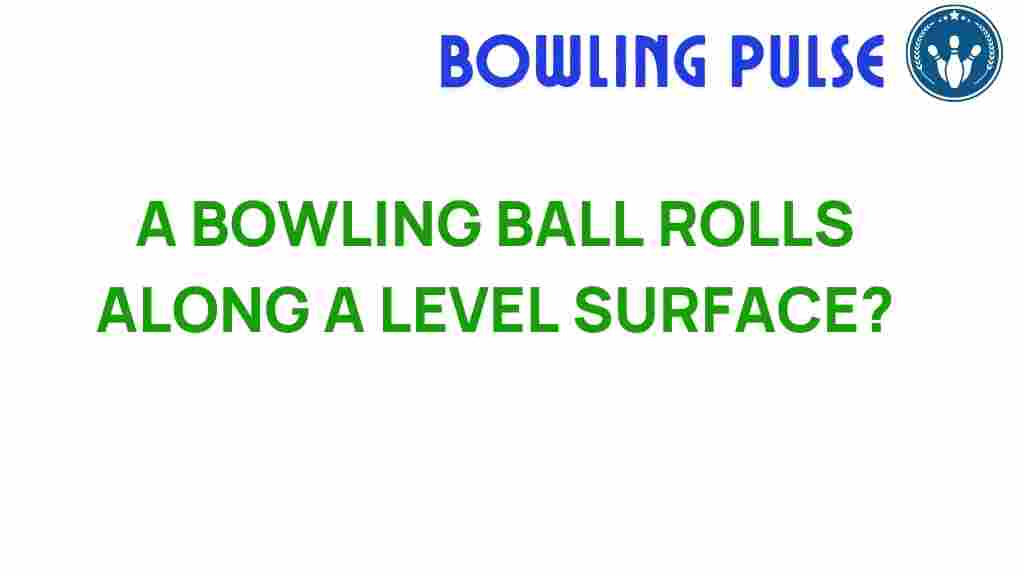The Physics Behind a Bowling Ball’s Journey on a Flat Lane
Bowling is more than just a pastime; it is a captivating blend of physics and sports science. When a bowler rolls a bowling ball down a flat lane, numerous physical principles come into play, dictating the ball’s motion, trajectory, and eventual fate in the pins. Understanding the physics behind a bowling ball’s journey can enhance a player’s performance and appreciation for the game.
Understanding the Basics of Motion and Dynamics
At the heart of bowling is the concept of motion. The **physics** involved in a bowling ball’s journey encompasses several principles, including Newton’s laws of motion, friction, and rolling dynamics. Let’s break down these concepts:
- Newton’s First Law: An object at rest stays at rest, and an object in motion stays in motion unless acted upon by an external force. When a bowler releases the bowling ball, it will roll down the flat lane until forces like friction or collisions with pins alter its state.
- Newton’s Second Law: The acceleration of an object depends on the net force acting upon it and its mass (F=ma). A heavier bowling ball will require more force to achieve the same acceleration as a lighter one.
- Newton’s Third Law: For every action, there is an equal and opposite reaction. The force the bowler applies to the ball propels it forward while the ball exerts a backward force on the bowler’s hand.
The Role of Friction in Bowling
Friction is a crucial factor in the **bowling ball**’s journey. As the ball rolls down the flat lane, it experiences two types of friction:
- Static Friction: When the ball is initially released, it is stationary in relation to the lane. The static friction between the ball and the lane must be overcome to get the ball rolling.
- Kinetic Friction: Once the ball is rolling, kinetic friction acts between the ball and the lane surface. This friction is responsible for slowing the ball down over time and affects its trajectory.
The amount of friction is influenced by various factors, including the lane’s surface material, the ball’s surface texture, and the oil patterns applied to the lane. A good understanding of these factors can help bowlers adjust their techniques for optimal performance.
Rolling Dynamics of a Bowling Ball
The motion of a bowling ball can be complex due to rolling dynamics. Unlike sliding, rolling involves both translational and rotational motion. Here are some key points:
- The center of mass of the bowling ball moves forward while the ball rolls without slipping.
- The moment of inertia of the bowling ball affects how easily it can start rolling. A ball with a higher moment of inertia will resist changes to its rolling motion.
- The frictional force must be sufficient to prevent slipping, allowing the ball to roll smoothly down the lane.
Analyzing Trajectory and Angle
The trajectory of a bowling ball is vital for consistent performance. The angle at which the bowler releases the ball can significantly affect its path and the overall outcome. Key factors include:
- Release Angle: The angle at which the ball is released influences its trajectory. A higher release angle can result in a more arcing path.
- Spin: Adding spin to the ball can alter its trajectory due to the Magnus effect, where the ball curves in the air. This can help in targeting the pins more effectively.
- Bowling Ball Weight: Heavier balls tend to travel straighter but require more force to roll. Lighter balls can be spun more easily but may be more affected by lane conditions.
Step-by-Step Process of a Bowling Ball’s Journey
Now that we have discussed the fundamental physics, let’s delve into the step-by-step journey of a bowling ball down a flat lane:
- Preparation: The bowler selects a bowling ball, considering weight, grip, and surface texture.
- Approach: The bowler takes a few steps towards the lane, generating momentum.
- Release: The bowler releases the ball at an optimal angle, ensuring proper spin and speed.
- Rolling: The ball begins to roll down the lane, experiencing static and kinetic friction.
- Trajectory Adjustment: The ball’s trajectory can be influenced by the bowler’s technique and the lane conditions.
- Impact: The ball collides with the pins, transferring energy and causing them to scatter.
Troubleshooting Common Issues
Even the most skilled bowlers encounter challenges. Here are some common issues and how to address them:
- Ball Hooking Too Much: If the ball curves excessively, consider adjusting your release angle or reducing the amount of spin.
- Ball Going Straight: If the ball lacks a hook, try increasing your wrist rotation during release for better spin.
- Inconsistent Speed: Work on your approach and timing to maintain a consistent release speed.
For more detailed techniques and training tips, you can refer to this resource.
Conclusion: The Intersection of Physics and Sports Science in Bowling
The journey of a bowling ball on a flat lane serves as a fascinating example of motion, dynamics, and the interplay of physical forces. By understanding the **physics** behind the bowling ball’s journey, players can enhance their performance and enjoy the sport on a deeper level. Whether you’re a beginner or a seasoned pro, recognizing the principles at work can help you refine your technique, improve your game, and appreciate the science behind this beloved sport.
For those interested in diving even deeper into the world of bowling and sports science, consider exploring additional resources and studies that focus on the mechanics of bowling and how they can impact performance. Understanding these principles not only makes you a better bowler but also enriches your appreciation for the sport.
This article is in the category Techniques and created by BowlingPulse Team
